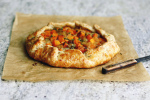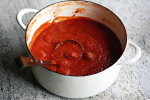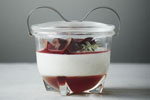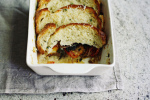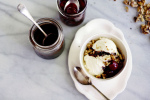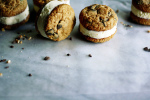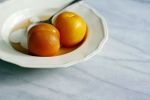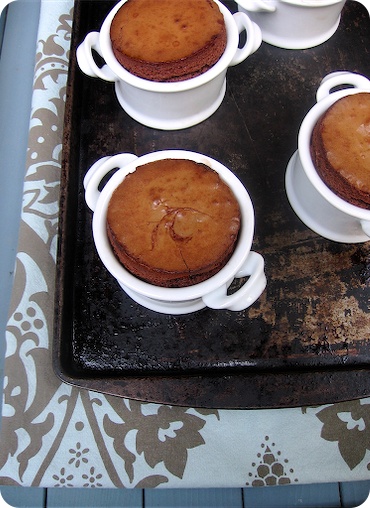
I am always struck by the generosity and kindness of those of you who read this site. Even with my recent absence (which will be explained in an upcoming post), I have still been the regular recipient of a host of comments, queries and stories from many of you. I cannot tell you how much this all means to me.
It was in one of these recent messages that Lillian, an enthusiastic and engaging reader from Louisiana, took the time to mention a recipe and entry for gaufrettes she'd come across. From the book French cooking for Americans by Louis Diat, here is the entry. My thanks to her.
Gaufres
Trace French cookery through the years and you will find certain specialties such as Gaufres, appearing century after century. These thin crisp, waffle-like tidbits have been sold on the streets of French cities ever since the twelfth century. In those early days the marchands de gaufres, that is, the vendors who sold them, always set up business in the streets near the doors of cathedrals and churches on days of great religious festivals. There they made and sold their wares to the throngs of people coming from the mass, people whose devotions must surely have been interrupted by the drifting fragrance of gaufres sizzling outside. Gaufres are still sold in French cities but today you will find them more often in the parks where the youngsters congregate.
Gaufres are cooked in an iron called a gaufrier which has two flat iron plates clamped and held together by long handles. The iron plates are decorated with designs which become imprinted on the cakes and very old gaufriers have beautiful and interesting designs, many of which have some definite religious significance.
My mother baked a kind of gaufre on a baking sheet and rolled them on a small stick. When cold she filled them with a cream filling or whipped cream. They are called gaufrettes, sometimes cigarettes.
My favorites are Gaufres with Cream, sometimes called Gaufres de Bruxelles, made in an oblong iron which puts deep indentations on the cakes, much like an American waffle iron. I think an American waffle iron could be used. Bur for a real gaufrier, if you have nostalgia for one, seek out an importer of French cooking equipment to supply you.
Gaufrettes or cigarettes
In giving the proportions of ingredients for gaufrettes it is almost impossible to indicate exact measurements because the size of the egg whites and the kind of flour will affect the consistency. It is best to bake a trial one. If the finished gaufrette is so thin it breaks and cannot be handled, the mixture needs a little more flour. If on the other hand the gaufrette is thick and clumsy to roll, a little more melted butter should be added.
2 egg whites
1/2 cup sugar
vanilla extract (or seeds from bean)
3 tablespoons butter, melted and cooled
1/3 cup flour
Beat egg whites until stiff. Sprinkle sugar over them a little at a time and fold into egg whites slowly and carefully. Add flour the same way. Add butter, also folding it in carefully. Butter and flour a baking sheet and put into a hot oven of 450 to 475 degrees until pan is hot. Drop batter by tablespoons on the hot pan, spreading it as thinly as possible. Bake in a hot oven of 450 to 475 degrees a few minutes until golden brown. When done, roll while still hot around a stick about the size of a thick pencil. When cold serve plain or filled with cream filling of whipped cream.
Batter for Gaufres
1 1/3 cups flour
2/3 cup sugar
4 tablespoons butter, melted
2 eggs
1 egg yolk
milk (3/4 to 1 cup)
vanilla extract (or seeds from bean)
Sift together flour and sugar. Mix together egg and egg yolk, add to flour mixture and mix until smooth. Add butter, vanilla and milk to make a thin batter. (Batter should be about the thickness or a crepe batter.) Heat both sides of gaufrier on top of stove, then butter both sides. When butter is sizzling hot pour in a tablespoon of batter, spreading it thinly. Close gaufrier and cook a few minutes on each side, or until golden brown. While still hot roll around the handle of a wooden spoon or stick of similar size. Or if preferred leave them flat.
Gaufrettes with cream
These gaufrettes are baked in a special iron, one that is square in shape, and made with deep indentations, as contrasted with the usual flat, round gaufrier. It is in fact very much like a waffle iron. The finished gaufrette is both soft and crisp, is very light and exceedingly tender and delicate. The advantage of these gaufrettes over waffles is that they are served cold and so can be made up ahead of time. They are a very choice dainty for afternoon tea when something rich is desired.
1 cup flour
6 egg yolks
1 tablespoon sugar
1/4 cup cream
1/4 cup butter, melted and cooled
pinch of salt
6 egg whites
Put all ingredients except egg whites in a bowl and mix together. Beat egg whites until stiff and carefully fold into batter. Pour into a square gaufrier with deep indentations (or a waffle iron) that has been heated and buttered. Cook on both sides until brown. Remove and cool. Fill each of the small holes with sweetened whipped cream or Creme Patissiere (recipe follows). Makes 6.
Crème patissiere
Pastry creams include all the cream fillings used in making various kinds of pastry desserts. Some of these creamy mixtures such as crème patissiere are also the foundations for many other desserts or, as we call them, entremets. Since most of these creams contain eggs it is important to know how to handle eggs when adding them to hot mixtures. You can't just stir them in as you do many other ingredients because when eggs are added directly to a hot liquid they will curdle. Nor can you allow the mixture to boil after eggs are added because that, too, will cause them to curdle. (If the mixture contains a thickening such as flour or cornstarch it can be boiled for minute or two.) The following simple procedure will insure the desired smooth, delicate texture: add some of the hot liquid to the beaten eggs, stirring vigorously all the time, in order to thin them out a little and heat them up at the same time. Then turn this back into the hot mixture and stir constantly until boiling point is reached. Do not allow to boil. Remove from heat and pour immediately into a cold bowl and cool quickly. The quicker a pastry cream cools the better, and an occasional stirring will prevent a thin crust from forming on top.
3/4 cup sugar
5-6 eggs
1/3 cup flour
2 cups milk
1 piece vanilla bean (or extract)
pinch salt
Mix together sugar and egg yolks and work up with a spoon until the mixture is creamy and light colored. Add flour and mix just enough to combine it but don't work it up. Scald milk and vanilla bean. Add to egg yolk mixture, little by little, and stir until well combined. Turn mixture back into saucepan and cook, stirring vigorously, until it comes back to boiling point. Boil about 2 minutes. Remove vanilla bean (or add extract to taste). Strain and let cool, stirring occasionally, to prevent a crust from forming on top.
Please see original post below for the backstory.
Some time ago, one of my dear readers requested a recipe for gaufrettes, the delicate French waffle cookie. I divided my attention between research and the demands of a toddler, trolling my cookbooks and searching online. Sadly, I was disappointed with my findings. None of my cookbooks garnered success; on the upside I shall be using this as an excuse to buy more. After all that, the delay only came up with the following links:
Category Mistake
Sweet C
Free Cooking Recipes
Recipe Link
However, never having tried any of them, I am wary to recommend these results. And so, I'm appealing to the rest of my readers - do any of you have an absolutely fantastic, full-proof and wonderful recipe you would be so kind to share? Or would those with more expertise comment on the links I have listed? Please contact me via my profile or post your thoughts in the comments section.
I have tried this recipe from Williams-Sonoma for gloriously tempting pizzelle. While not exactly a gaufrette, I am more than happy to vouch for their deliciousness.
And to the original reader, thank you for your patience!
 Monday, December 10, 2007 at 9:09AM
Monday, December 10, 2007 at 9:09AM 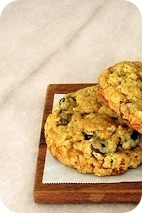


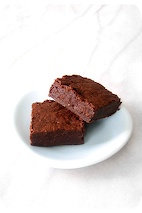
 charity,
charity,  event,
event,  menu for hope,
menu for hope,  season
season 

